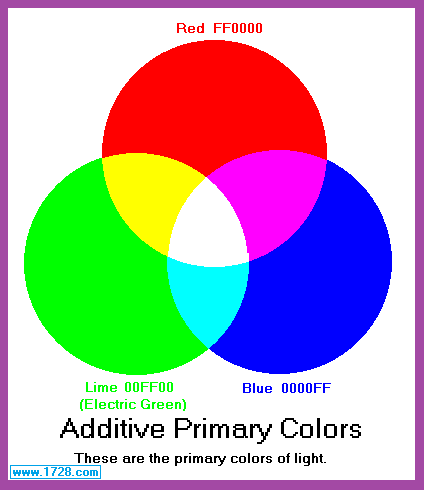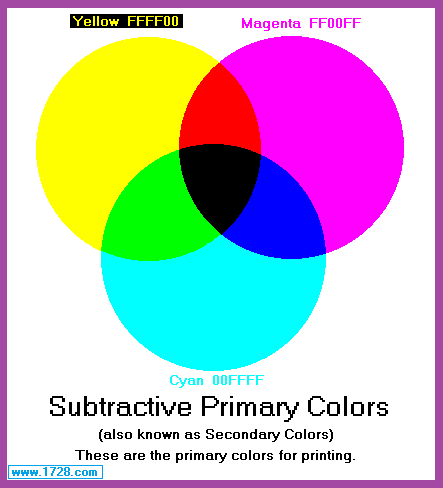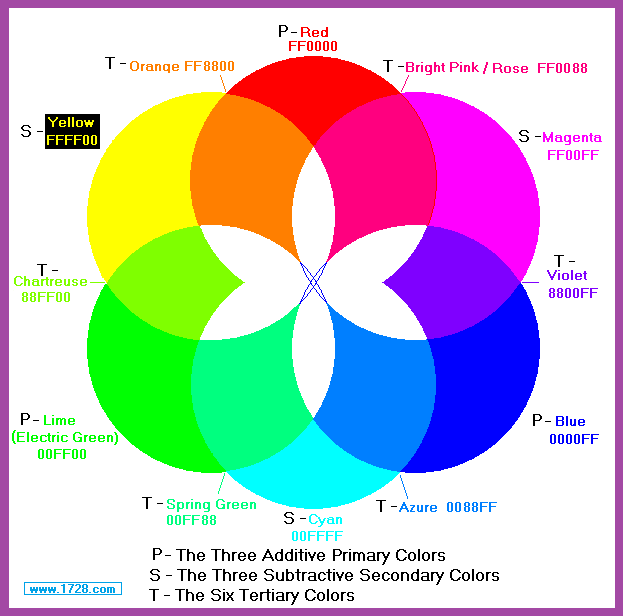
|
Perhaps you have learned in school that the three primary colors are red, yellow and blue. Actually that was based on a system that goes back centuries and even to this day, artists still use these as their primary colors. However, in the 20th century, color theory was examined scientifically and the primary colors are now known to be red, green (actually lime or electric green) and blue because their wavelengths are spread more evenly across the visible light spectrum. Pictured above is a graphic displaying red, lime and blue as the 3 primary colors (along with their HTML hexadecimal codes). These are called additive primary colors because they are the primary colors of light which explains why mixing any combination of these will always produce a brighter color. Because these are the primary colors of light, these 3 colors are used for televisions and computer monitors. Incidentally, in HTML, colors are displayed by using 6 digit hexadecimal (base 16) numbers. The first 2 digits control how much red to display, the third and fourth digits are the amount of green and the fifth and sixth digits determine the amount of blue to display. Looking at the above graphic, we see the hexadecimal code for red is FF0000. As we stated, the first 2 digits "FF" control the amount of red. Since "FF" is the largest 2 digit hexadecimal number, that means it will display the full amount of red. The green and blue digits are all zero so that means this displayed color will have zero amounts of green and blue. You can see how this holds true by looking at the other 2 hexadecimal color codes.
You probably noticed that mixing these three colors produces three additional colors (called secondary colors):
|
|

These are called subtractive primary colors because mixing any combination of these will always produce a darker color.
These are also known as secondary colors.
As a quick example, look at the toner cartridges inside your prtinter. No doubt you saw cartridges for yellow, magenta and cyan (along with a cartridge for black).
You probably noticed that mixing these three subtractive primary colors produces the three additive primary colors: |
| yellow and magenta = | red |
| yellow and cyan = | lime |
| cyan and magenta = | blue |
|
Now let's see what happens when we combine the above 2 graphics.

|
|
* * * * * * * * * * * * * * * * * * * * * * * * * * * * * *
RGB Primary, Secondary & Tertiary Colors
|
| Color Name Comments HEX Code |
Primary, Secondary and Tertiary Colors In The Following Order RED BRIGHT PINK MAGENTA VIOLET BLUE AZURE CYAN SPRING GREEN GREEN CHARTREUSE YELLOW ORANGE |
| RED Primary color #FF0000 |
ROSE / BRIGHT PINK Tertiary color #FF0080 |
MAGENTA (FUCHSIA) Secondary color #FF00FF |
VIOLET Tertiary color #8800FF |
BLUE Primary color #0000FF |
AZURE Tertiary color #0088FF |
CYAN (AQUA) Secondary color #00FFFF |
SPRING GREEN Tertiary color #00FF88 |
GREEN (LIME) Primary color #00FF00 |
CHARTREUSE Tertiary color #88FF00 |
YELLOW Secondary color #FFFF00 |
ORANGE Tertiary color #FF8800 |
| Color Name Comments HEX Code |
Primary, Secondary and Tertiary Colors IN ORDER BY HEX Code From 0000FF to FFFF00 |
| BLUE Primary color #0000FF |
AZURE Tertiary color #0088FF |
GREEN (LIME) Primary color #00FF00 |
SPRING GREEN Tertiary color #00FF88 |
CYAN (AQUA) Secondary color #00FFFF |
VIOLET Tertiary color #8800FF |
CHARTREUSE Tertiary color #88FF00 |
RED Primary color #FF0000 |
ROSE / BRIGHT PINK Tertiary color #FF0088 |
MAGENTA (FUCHSIA) Secondary color #FF00FF |
ORANGE Tertiary color #FF8800 |
YELLOW Secondary color #FFFF00 |